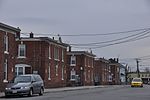Holihan Brothers
Brewery buildings in the United StatesCompanies based in Lawrence, MassachusettsDefunct brewery companies of the United StatesDistilleries in Massachusetts

Holihan Brothers of Lawrence, Mass. began as a producer of whiskeys in 1856. They operated the Diamond Spring Brewery from 1912 until around Prohibition and then opened after Prohibition in 1933. They produced beer and ales under the Holihan's and Diamond Spring labels. The company also made soda beginning in 1917.
Excerpt from the Wikipedia article Holihan Brothers (License: CC BY-SA 3.0, Authors, Images).Holihan Brothers
Diamond Street, Lawrence
Geographical coordinates (GPS) Address Nearby Places Show on map
Geographical coordinates (GPS)
| Latitude | Longitude |
|---|---|
| N 42.689 ° | E -71.1717 ° |
Address
Diamond Street 10
01840 Lawrence
Massachusetts, United States
Open on Google Maps









